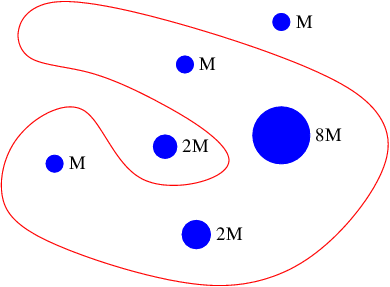13.8: Problems
( \newcommand{\kernel}{\mathrm{null}\,}\)
- Assume a mass M is located at (-2 m, 0 m) and a mass 2M is located at (0 m, 3 m). Find the (vector) gravitational field at the point (1 m, 1 m).
- If two equal masses M are located at x 1 = (-3 m, -4 m) and x 2 = (-3 m, +4 m), determine where a third mass M must be placed to result in zero gravitational force at the origin.
- Given the value of g at the Earth’s surface, the radius of the Earth (look it up), and the universal gravitational constant G, determine the mass of the Earth.
- Given the situation in Figure 13.8.9::
- What is the gravitational flux through the illustrated surface?
- Explain why you cannot use this information to compute the gravitational field on the surface in this case.
Figure 13.8.9:: Various masses inside and outside a Gaussian surface.
- Suppose mass is distributed uniformly with density μ kg m-1 in an infinite thin line along the z axis. Try to figure out a way of using Gauss’s law and symmetry arguments to predict the gravitational field resulting from this mass distribution.
- Assume that the Earth is of uniform density, ρ.
- Use Gauss’s law to determine the gravitational field inside the Earth as a function of distance from the center.
- Using the results of the above problem, determine the motion of an object moving through an evacuated hole drilled through the center of the Earth. Ignore the Earth’s rotation.
- Two infinite thin sheets of mass, each with σ mass per unit area, are aligned perpendicular to each other. Determine the gravitational field from this combination. Hint: Compute g from each sheet separately and add vectorially.
- Suppose that the universal law of gravitation says that the (attractive) gravitational force takes the form F = M 1M 2Gr, where r is the separation between the two masses M 1 and M 2 and G is a constant. Find the relationship between the orbital radius and the period for a circular orbit of a planet around the sun in this case.
- An alien spaceship enters the solar system at distance D from the sun with speed v 0. (D may be considered to be very far from the sun.) It coasts through the solar system, approaching within a distance d ≪ D of the sun.
- Find its speed at the point of closest approach.
- Find the angular momentum of the spaceship with respect to the center of the sun.
- What was the tangential component of the spaceship’s velocity (i. e., the component normal to the radius vector) when it entered the solar system at distance D ?
- As a result of tidal torques, the spin angular momentum of the Earth is gradually being converted into orbital angular momentum of the moon, which causes the radius of the moon’s (circular) orbit to increase. Hint: Recall that for a solid sphere the moment of inertia is I = 2mr 2∕ 5.
- Obtain a relationship between the moon’s orbital velocity and its distance from the Earth, assuming that the orbit is circular.
- If the Earth’s rotation rate is cut in half due to this effect, what will the new radius of the moon’s orbit be?

